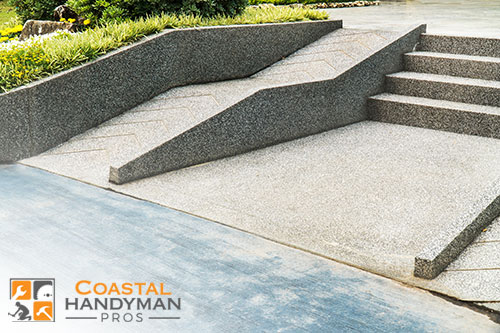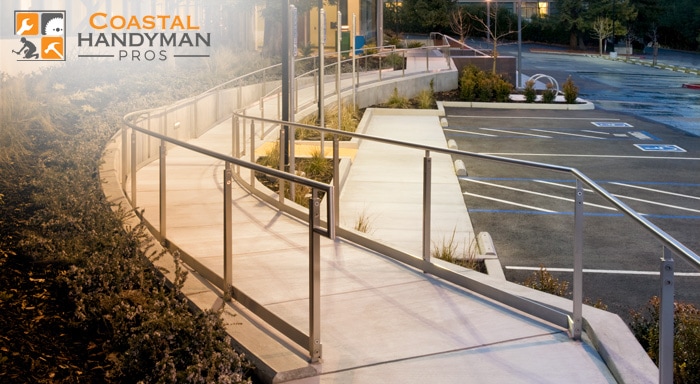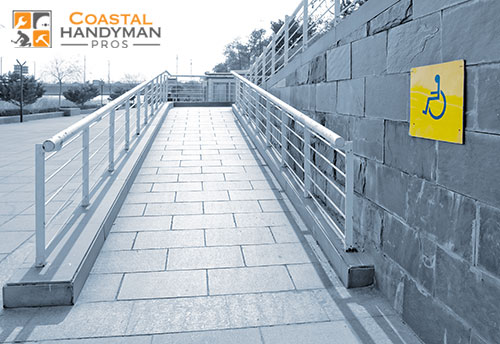When providing handicap access to your building, it’s important to ensure that it meets the minimum requirements of the Americans with Disabilities Act (ADA). Most residential properties don’t need to concern themselves with these guidelines, but for commercial properties and businesses, it’s important to understand what the ADA specifications are regarding wheelchair ramp installation.
Call: (949) 415-4534 to get started
Who needs to follow ADA construction guidelines?
In most cases, only businesses and commercial properties will need to follow ADA construction guidelines. Residential properties are considered private and do not need to follow ADA guidelines as they do not provide a public service. However, there are exceptions to this when it comes to a place of public accommodation. For example, if there is a daycare center, doctor’s office or community centre located in a private residence, those portions of the residence must adhere to the ADA’s requirements.
If you’re unsure whether you need to follow the ADA’s construction guidelines or not, feel free to contact us today for more information about the guidelines. If you’re just interested in making your home more accessible for people with disabilities, then we’d be more than happy to assist you with our specialized construction services.
ADA Ramp Specifications
Here are the ADA wheelchair ramp requirements:
- The maximum slope of a wheelchair ramp in new construction must be a 1:12 ramp slope ratio and the maximum rise must be 30 inches (760 mm)
- The minimum clear width of a ramp must be 36 inches (915 mm)
- Ramps must have level landings at both the bottom and top. The landings must:
- Be at least as wide as the ramp run leading to it
- Be a minimum of 60 inches (1525 mm) clear
- If the ramp changes direction at landings, the landing size must be 60 inches by 60 inches (1525 mm by 1525mm)
- If there’s a doorway at the landing, the area in front of it must comply with 4.13.6 Maneuvering Clearances at Doors.
- If a ramp run has a rise greater than 6 inches (150 mm) or a horizontal projection over 72 inches (1830 mm) then it must have handrails on both sides. These must comply with 4.26 Handrails, Grab
- Bars, and Tub and Shower Seats. In addition, handrails must also:
- Be provided along both sides of the ramp
- The inside handrail on switchback or dogleg ramps must always be continuous
- If they are not continuous, they must extend at least 12 inches (305 mm) beyond the top and bottom of the ramp and must be parallel with the ground
- The space between the handrail and the wall must be 1 – ½ inches (38 mm)
- Gripping surfaces must be continuous
- The top of handrail gripping surfaces must be mounted between 34 inches and 38 inches (865 mm and 965 mm) above ramp surfaces
- Handrail ends must be rounded or returned smoothly to floor, wall or post
- Handrails must not rotate within fittings
- The cross slope of ramp surfaces must be no greater than a ratio of 1:50. Ramp surfaces must also comply with 4.5 Ground and Floor Surfaces.
- Ramps and landings with drop-offs must have curbs, walls, railings or projecting surfaces that prevent people from slipping off it. Curbs must be a minimum of 2 inches (50 mm) high.
- Outdoor ramps and their approaches must be designed in a way that water does not accumulate on the surfaces.
As you can see, there are a strict set of guidelines involved in the construction of a concrete ADA-compliant wheelchair ramp. While residential property owners can use these guidelines to construct a practical wheelchair ramp, businesses and commercial property owners must adhere to these guidelines.
If you’re looking for Orange County structural concrete contractor that understand and follow ADA compliance when installing wheelchair ramps, don’t hesitate to get in touch with us at John Christopher Construction for more information.
The penalties of ADA compliance failure

ADA compliance can be enforced by the Department of Justice in federal court. Courts may also order compensatory charges and back pay. The Department of Justice also has the power to fine you for civil penalties of up to $55,000 for the first ADA compliance violation and an additional $110,000 for subsequent violations.
As such, it’s important that you understand ADA compliance in relation to your commercial or business property. This is where John Christopher Construction comes in. We’re confident that we can save you from having to deal with the stress of being taken to court over handicap access complaints. We provide a number of ADA-compliant construction and contractor services in Orange County to ensure that you never have to face an ADA compliance penalty.
Simply get in touch with us today for more information regarding our services, or to speak to one of our specialists regarding ADA wheelchair ramp requirements.
Get in touch with us today
Whether you’re preparing a commercial property for a grand opening or want to make your home more accessible, John Christopher Construction would be happy to help with all of your construction needs. Call us today on (949) 216 5858 to get in touch, or send us a message to request a callback.
In addition to our ADA wheelchair ramp installation services, we also offer a wide range of general repair and installation services that are suitable for both residential and commercial customers. Take a look at the relevant categories at the top of the page to learn more about the services that we provide to residents in Orange County and surrounding areas.


